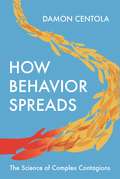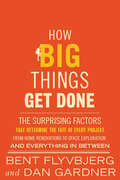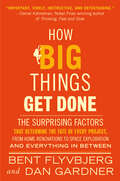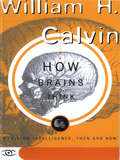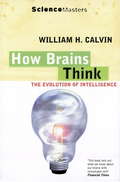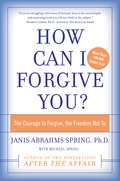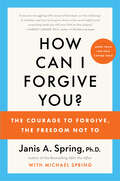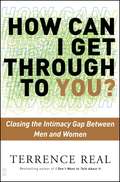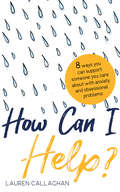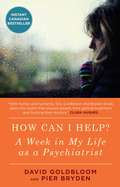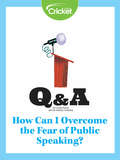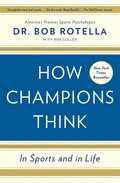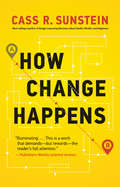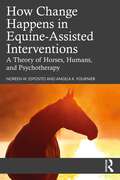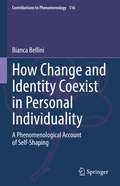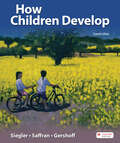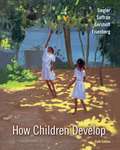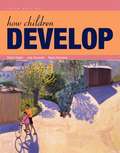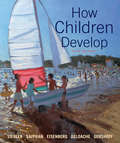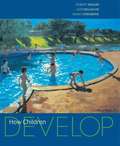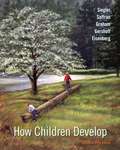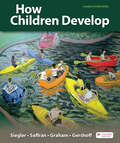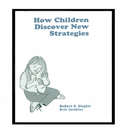- Table View
- List View
How Authors' Minds Make Stories
by Patrick Colm HoganThis book explores how the creations of great authors result from the same operations as our everyday counterfactual and hypothetical imaginations, which cognitive scientists refer to as "simulations. " Drawing on detailed literary analyses as well as recent research in neuroscience and related fields, Patrick Colm Hogan develops a rigorous theory of the principles governing simulation that goes beyond any existing framework. He examines the functions and mechanisms of narrative imagination, with particular attention to the role of theory of mind, and relates this analysis to narrative universals. In the course of this theoretical discussion, Hogan explores works by Austen, Faulkner, Shakespeare, Racine, Brecht, Kafka, and Calvino. He pays particular attention to the principles and parameters defining an author's narrative idiolect, examining the cognitive and emotional continuities that span an individual author's body of work.
How Behavior Spreads: The Science of Complex Contagions (Princeton Analytical Sociology Series #3)
by Damon CentolaA new, counterintuitive theory for how social networks influence the spread of behaviorNew social movements, technologies, and public-health initiatives often struggle to take off, yet many diseases disperse rapidly without issue. Can the lessons learned from the viral diffusion of diseases be used to improve the spread of beneficial behaviors and innovations? In How Behavior Spreads, Damon Centola presents over a decade of original research examining how changes in societal behavior--in voting, health, technology, and finance—occur and the ways social networks can be used to influence how they propagate. Centola's startling findings show that the same conditions accelerating the viral expansion of an epidemic unexpectedly inhibit the spread of behaviors. While it is commonly believed that "weak ties"—long-distance connections linking acquaintances—lead to the quicker spread of behaviors, in fact the exact opposite holds true. Centola demonstrates how the most well-known, intuitive ideas about social networks have caused past diffusion efforts to fail, and how such efforts might succeed in the future. Pioneering the use of Web-based methods to understand how changes in people's social networks alter their behaviors, Centola illustrates the ways in which these insights can be applied to solve countless problems of organizational change, cultural evolution, and social innovation. His findings offer important lessons for public health workers, entrepreneurs, and activists looking to harness networks for social change.Practical and informative, How Behavior Spreads is a must-read for anyone interested in how the theory of social networks can transform our world.
How Big Things Get Done: The Surprising Factors That Determine the Fate of Every Project, from Home Renovations to Space Exploration and Everything In Between
by Bent Flyvbjerg Dan GardnerThe secrets to successfully planning and delivering ambitious, complex projects on any scale—from home renovation to space exploration—by the world's leading expert on megaprojects.Nothing is more inspiring than a big vision that becomes a triumphant, new reality. Think of how the Empire State Building went from a sketch to the jewel of New York's skyline in twenty-one months, or how Apple&’s iPod went from a project with a single employee to a product launch in eleven months.These are wonderful stories. But most of the time big visions turn into nightmares. Remember Boston&’s &“Big Dig&”? Almost every sizeable city in the world has such a fiasco in its backyard. In fact, no less than 92% of megaprojects come in over budget or over schedule, or both. The cost of California&’s high-speed rail project soared from $33 billion to $100 billon—and won&’t even go where promised. More modest endeavors, whether launching a small business, organizing a conference, or just finishing a work project on time, also commonly fail. Why?Understanding what distinguishes the triumphs from the failures has been the life&’s work of Oxford professor Bent Flyvbjerg, dubbed &“the world&’s leading megaproject expert.&” In How Big Things Get Done, he identifies the errors in judgment and decision-making that lead projects, both big and small, to fail, and the research-based principles that will make you succeed with yours. For example:Understand your odds. If you don't know them, you won't win.Plan slow, act fast. Getting to the action quick feels right. But it's wrong. Think right to left. Start with your goal, then identify the steps to get there.Find your Lego. Big is best built from small.Be a team maker. You won't succeed without an "us."Master the unknown unknowns. Most think they can't, so they fail. Flyvbjerg shows how you can.Know that your biggest risk is you.Full of vivid examples ranging from the building of the Sydney Opera House, to the making of the latest Pixar blockbusters, to a home renovation in Brooklyn gone awry, How Big Things Get Done reveals how to get any ambitious project done—on time and on budget.
How Big Things Get Done: The Surprising Factors That Determine the Fate of Every Project, from Home Renovations to Space Exploration and Everything In Between
by Bent Flyvbjerg Dan Gardner&“Why do big projects go wrong so often, and are there any lessons you can use when renovating your kitchen? Bent Flyvbjerg is the &‘megaproject&’ expert and Dan Gardner brings the storytelling skills to How Big Things Get Done, with examples ranging from a Jimi Hendrix studio to the Sydney Opera House.&”—Financial Times &“Entertaining . . . There are lessons here for managers of all stripes.&”—The EconomistA BEST BOOK OF THE YEAR: Economist, Financial Times, CEO Magazine, MorningstarFinalist for the Porchlight Business Book Award, the Financial Times and Schroders Business Book of the Year Award, and the Inc. Non-Obvious Book AwardNothing is more inspiring than a big vision that becomes a triumphant, new reality. Think of how the Empire State Building went from a sketch to the jewel of New York&’s skyline in twenty-one months, or how Apple&’s iPod went from a project with a single employee to a product launch in eleven months.These are wonderful stories. But most of the time big visions turn into nightmares. Remember Boston&’s &“Big Dig&”? Almost every sizeable city in the world has such a fiasco in its backyard. In fact, no less than 92% of megaprojects come in over budget or over schedule, or both. The cost of California&’s high-speed rail project soared from $33 billion to $100 billon—and won&’t even go where promised. More modest endeavors, whether launching a small business, organizing a conference, or just finishing a work project on time, also commonly fail. Why?Understanding what distinguishes the triumphs from the failures has been the life&’s work of Oxford professor Bent Flyvbjerg, dubbed &“the world&’s leading megaproject expert.&” In How Big Things Get Done, he identifies the errors in judgment and decision-making that lead projects, both big and small, to fail, and the research-based principles that will make you succeed with yours. For example:• Understand your odds. If you don&’t know them, you won&’t win.• Plan slow, act fast. Getting to the action quick feels right. But it&’s wrong. • Think right to left. Start with your goal, then identify the steps to get there.• Find your Lego. Big is best built from small.• Be a team maker. You won&’t succeed without an &“us.&”• Master the unknown unknowns. Most think they can&’t, so they fail. Flyvbjerg shows how you can.• Know that your biggest risk is you.Full of vivid examples ranging from the building of the Sydney Opera House, to the making of the latest Pixar blockbusters, to a home renovation in Brooklyn gone awry, How Big Things Get Done reveals how to get any ambitious project done—on time and on budget.
How Brains Think: Evolving Intelligence, Then And Now
by William H. CalvinIf you’re good at finding the one right answer to life’s multiple-choice questions, you’re ”smart. ” But ”intelligence” is what you need when contemplating the leftovers in the refrigerator, trying to figure out what might go with them; or if you’re trying to speak a sentence that you’ve never spoken before. As Jean Piaget said, intelligence is what you use when you don’t know what to do, when all the standard answers are inadequate. This book tries to fathom how our inner life evolves from one topic to another, as we create and reject alternatives. Ever since Darwin, we’ve known that elegant things can emerge (indeed, self-organize) from ”simpler” beginnings. And, says theoretical neurophysiologist William H. Calvin, the bootstrapping of new ideas works much like the immune response or the evolution of a new animal species--except that the brain can turn the Darwinian crank a lot faster, on the time scale of thought and action. Drawing on anthropology, evolutionary biology, linguistics, and the neurosciences, Calvin also considers how a more intelligent brain developed using slow biological improvements over the last few million years. Long ago, evolving jack-of-all trades versatility was encouraged by abrupt climate changes. Now, evolving intelligence uses a nonbiological track: augmenting human intelligence and building intelligent machines.
How Brains Think: Evolving Intelligence, Then And Now (SCIENCE MASTERS)
by William H. CalvinA new theory of Intelligence, from a renowned and highly respected writer on brains and evolutionWhat constitutes consciousness or intelligence? This is a question that has proved to philosophers to be an intellectual dead-end. Now William Calvin, by looking closely at animal and human intelligence and a wide range of evolutionary evidence, has broken new ground that will help us understand mental illness and illuminate the whole notion of what it is to be a person.Calvin begins by asking what intelligence is. He moves to the Why of intelligence, where evidence from chimpanzees is important, before coming to the all-important How of intelligence, the cerebral codes and Darwinian processes that operate within seconds to produce intelligent thought and action.
How Can I Forgive You?
by Janis A. SpringUntil now, we have been taught that forgiveness is good for us and that good people forgive. Dr. Spring, a gifted therapist and the award-winning author of After the Affair, proposes a radical, life-affirming alternative that lets us overcome the corrosive effects of hate and get on with our lives--without forgiving. She also offers a powerful and unconventional model for genuine forgiveness--one that asks as much of the offender as it does of us. This bold and healing book offers step-by-step, concrete instructions that help us make peace with others and with ourselves, while answering such crucial questions as these: How do I forgive someone who is unremorseful or dead? When is forgiveness cheap? What is wrong with refusing to forgive? How can the offender earn forgiveness? How do we forgive ourselves for hurting another human being?
How Can I Forgive You?
by Janis A. SpringUntil now, we have been taught that forgiveness is good for us and that good people forgive. Dr. Spring, a gifted therapist and the award-winning author of After the Affair, proposes a radical, life-affirming alternative that lets us overcome the corrosive effects of hate and get on with our lives--without forgiving. She also offers a powerful and unconventional model for genuine forgiveness--one that asks as much of the offender as it does of us.This bold and healing book offers step-by-step, concrete instructions that help us make peace with others and with ourselves, while answering such crucial questions as these:How do I forgive someone who is unremorseful or dead?When is forgiveness cheap?What is wrong with refusing to forgive?How can the offender earn forgiveness?How do we forgive ourselves for hurting another human being?
How Can I Forgive You?: The Courage to Forgive, the Freedom Not To
by Janis A. Spring“If you are struggling with issues of betrayal—or the challenge of whether and how to forgive—here is the most helpful and surprising book you will ever find on the subject.”—Harriet Lerner, Ph.D., author of The Dance of AngerEveryone is struggling to forgive someone: an unfaithful partner, an alcoholic parent, an ungrateful child, a terrorist. This award-winning book provides a radical way for hurt parties to heal themselves—without forgiving, as well as a way for offenders to earn genuine forgiveness.Until now, we’ve been taught that forgiveness is good for us and that good people forgive. Dr. Janis Abrahms Spring, a gifted clinical psychologist and award-winning author of After the Affair, proposes a radical, life-affirming alternative that lets us overcome the corrosive effects of hate and get on with our lives—without forgiving. She also offers a powerful and unconventional model for earning genuine forgiveness—one that asks as much of the offender as it does of the hurt party.Beautifully written and filled with insight, practical advice, and poignant case studies, this bold and healing book offers step-by-step, concrete instructions that help us make peace with others and ourselves, while answering such crucial questions as these:How do I forgive someone who is unremorseful or dead?When is forgiveness cheap?Can I heal myself – without forgiving?How can the offender earn forgiveness?What makes for a good apology?How do we forgive ourselves for hurting another human being?
How Can I Get Through to You?: Closing the Intimacy Gap Between Men and Women
by Terrence RealFrom &“a superstar couples therapist…and a maestro of interpersonal drama&” (The New York Times), this book offers solutions for attaining the relationships we want, filled with the love and intimacy we deserve.Bestselling author and nationally renowned therapist Terry Real unearths the causes of communication blocks between men and women in this groundbreaking work. Relationships are in trouble; the demand for intimacy today must be met with new skills, and Real—drawing on his pioneering work on male depression—gives both men and women those skills, empowering women and connecting men, radically reversing the attitudes and emotional stumbling blocks of the patriarchal culture in which we were raised. Filled with powerful stories of the couples Real treats, no other relationship book is as straight talking or compelling in its innovative approach to healing wounds and reconnecting partners with a new strength and understanding.
How Can I Help?: 8 Ways You Can Support Someone You Care About with Anxiety or Obsessional Problems
by Lauren CallaghanDo you have a friend, partner, child or loved one who’s suffering from anxiety? Do they need your help but you’re not quite sure what to do? Are you wondering how you can best support them?At some point in our lives, many of us will witness someone we’re close to experiencing anxiety, stress or anxiety-based depression. It can be challenging to see those you care about facing the challenges these conditions can cause, but there are ways that you can help. In this accessible, no-nonsense guide, clinical psychologist Lauren Callaghan provides tools, tips and strategies that you can use to help the person you love along the path to recovery. Whether your loved one has already been diagnosed, or whether you think that a loved one might be suffering but has not yet been diagnosed, there is something in here for you.
How Can I Help?: A Week in My Life as a Psychiatrist
by David Goldbloom Pier Bryden, M.D.A humane behind-the-scenes account of a week in the life of a psychiatrist at one of Canada’s leading mental health hospitals. How Can I Help? takes us to the frontlines of modern psychiatric care.How Can I Help? portrays a week in the life of Dr. David Goldbloom as he treats patients, communicates with families, and trains staff at CAMH, the largest psychiatric facility in Canada. This highly readable and touching behind-the-scenes account of his daily encounters with a wide range of psychiatric concerns—from his own patients and their families to Emergency Department arrivals—puts a human face on an often misunderstood area of medical expertise. From schizophrenia and borderline personality disorder to post-traumatic stress syndrome and autism, How Can I Help? investigates a range of mental issues. What is it like to work as a psychiatrist now? What are the rewards and challenges? What is the impact of the suffering—and the recovery—of people with mental illness on families and the clinicians who treat them? What does the future hold for psychiatric care? How Can I Help? demystifies a profession that has undergone profound change over the past twenty-five years, a profession that is often misunderstood by the public and the media, and even by doctors themselves. It offers a compassionate, realistic picture of a branch of medicine that is entering a new phase, as increasingly we are able to decode the mysteries of the brain and offer new hope for sufferers of mental illness.
How Can I Overcome the Fear of Public Speaking?
by Lizzie WadeSome people are afraid of public speaking more than others. Learn about some surprising ways to overcome stage fright.
How Champions Think: In Sports and in Life
by Dr. Bob RotellaAmerica’s preeminent sports psychologist delivers a groundbreaking guide to success in all aspects of life—not just sports—from business to relationships to personal challenges of every variety.Acclaimed sports psychologist Bob Rotella has advised everyone from professional golfers to NBA superstars to business executives on how to flourish under pressure and overcome challenges. Now, for the first time, he’s distilled his decades of in-depth research and practical experience into a potential-unlocking guide for everyone. This exciting book is not a collection of Rotella’s theories; it consists of performance principles that have proven themselves in countless competitive situations, in arenas from which only the strongest minds emerge triumphant. It’s a book full of insights that you can learn and use the next morning—in the office, the classroom, or wherever your quest takes you—told not in abstractions, but through case studies and stories drawn from Rotella’s years teaching sports psychology, counseling athletes, and consulting for Fortune 500 companies. It explores how to keep the mind from holding you back, whatever your physical gifts or other talents. It’s about how to make a commitment, how to persevere, how to deal with failure—and how to train your mind to create a self-image that promotes confidence and accomplishment. Any successful life starts with how you see yourself. And with these pearls of wisdom from the nation’s preeminent sports psychologist, you can learn to achieve the success of your dreams.
How Change Happens (The\mit Press Ser.)
by Cass R. SunsteinThe different ways that social change happens, from unleashing to nudging to social cascades."Sunstein's book is illuminating because it puts norms at the center of how we think about change."—David Brooks, The New York TimesHow does social change happen? When do social movements take off? Sexual harassment was once something that women had to endure; now a movement has risen up against it. White nationalist sentiments, on the other hand, were largely kept out of mainstream discourse; now there is no shortage of media outlets for them. In this book, with the help of behavioral economics, psychology, and other fields, Cass Sunstein casts a bright new light on how change happens.Sunstein focuses on the crucial role of social norms—and on their frequent collapse. When norms lead people to silence themselves, even an unpopular status quo can persist. Then one day, someone challenges the norm—a child who exclaims that the emperor has no clothes; a woman who says “me too.” Sometimes suppressed outrage is unleashed, and long-standing practices fall. Sometimes change is more gradual, as “nudges” help produce new and different decisions—apps that count calories; texted reminders of deadlines; automatic enrollment in green energy or pension plans. Sunstein explores what kinds of nudges are effective and shows why nudges sometimes give way to bans and mandates. Finally, he considers social divisions, social cascades, and “partyism,” when identification with a political party creates a strong bias against all members of an opposing party—which can both fuel and block social change.
How Change Happens in Equine-Assisted Interventions: A Theory of Horses, Humans, and Psychotherapy
by Angela K. Fournier Noreen W. EspositoHow Change Happens in Equine-Assisted Interventions gives clinicians and researchers an intervention theory on the mechanisms of change during psychotherapy and other interventions that incorporate horses. Chapters introduce the concept of intervention theory, present a theory of the problem (what the client comes with), theories explaining the intervention (what is done during a session), and theories of change (what happens in the mind of a client), with each theory’s function described. Using an autoethnographic approach, the authors describe, deconstruct, and analyze personal experiences as clients during an equine-assisted intervention. Then the authors present and apply a unique intervention theory by linking it to the thoughts and experiences of clients in and after a session. Practitioners will come away from this book with a unique perspective on the field and with an increased understanding of what their clients are thinking both in and out of session. Researchers will have an explanatory theory from which to draw testable hypotheses when studying interventions incorporating horses.
How Change and Identity Coexist in Personal Individuality: A Phenomenological Account of Self-Shaping (Contributions to Phenomenology #116)
by Bianca BelliniThis book purports to devise a pattern of the self that accounts for the role that change and identity play in self-shaping. It focuses on the process through which we discover, know and shape ourselves and wonder whether there is a core of our individuality and how we should account for it. The core is described along with its range of possible variations and its constraints. This volume provides arguments on how individual essence – far from being something monolithic – is inherently dynamic.The text delves into the link between change and identity in self-shaping, arguably the fundamental issue of personal individuality. Different theories and standpoints are addressed and scrutinized. Descriptive phenomenology will enter along with Max Scheler’s stance on axiology, as well as the keystones that account for self-shaping. This book appeals to students and researchers working on the implications of phenomenology for self identification and personal individuality.
How Children Develop
by Nancy Eisenberg Robert Siegler Campbell Leaper Jenny SaffranHow Children Develop, Seventh Edition, is the trusted introduction to child development from a team of leading teachers and researchers.
How Children Develop
by Nancy Eisenberg Robert Siegler Elizabeth Gershoff Jenny SaffranHow Children Develop has established itself as the topically organized textbook teachers and researchers trust for the most up-to-date perspectives on child and adolescent development. The authors, each a well-known scientist and educator—have earned that trust by introducing core concepts and impactful discoveries with an unparalleled integration of theory, cultural research, and applications, all in a style that is authoritative yet immediately understandable and relevant to students. The new edition includes a robust and carefully curated video program, called out within the margins of the text.
How Children Develop
by Nancy Eisenberg Robert S. Siegler Judy S. DeLoacheWorth is proud to publish the Third Edition of How Children Develop by Robert S. Siegler, Judy S. DeLoache, and Nancy Eisenberg—the leading textbook for the topically-organized child development course. Providing a fresh perspective on the field of child development, the authors emphasize fundamental principles, enduring themes, and important recent studies to provide a unique contribution to the teaching of child development.
How Children Develop (Fifth Edition)
by Nancy Eisenberg Judy Deloache Robert Siegler Jenny R. Saffran Elizabeth Gershoff Campbell LeaperHow Children Develop has established itself as the topically organized textbook teachers and researchers trust for the most up-to-date perspectives on child development. The authors, each a well-known scientist and educator--have earned that trust by introducing core concepts and impactful discoveries with an unparalleled integration of theory, cultural research, and applications, all in a style that is authoritative yet immediately understandable and relevant to students. The new edition has been rigorously updated and welcomes co-author Elizabeth Gershoff (The University of Texas at Austin), who brings a breadth of research and teaching experience to the discussions of social and emotional development. It is also more interactive than ever before, with richer integration between the book and its interactive study features in LaunchPad.
How Children Develop (First Edition)
by Nancy Eisenberg Judy Deloache Robert SieglerCollege textbook about child development.
How Children Develop, Canadian Edition
by Nancy Eisenberg Robert S. Siegler Elizabeth Gershoff Susan Graham Jenny SaffranHow Children Develop continues to be the topically arranged textbook that teachers and researchers trust for the most up to date perspectives on the field of child development. The book has also been fully adapted for a Canadian audience with special attention to Canadian research and topics of special relevance, offering Canadian readers an organic and engaging reading experience. This edition is also more interactive than ever before with a full suite of media for students to learn and practice the material in the LaunchPad course space. In addition to the full eBook, students have access to the book’s celebrated video program, the LearningCurve adaptive quizzing system with a personalized study plan, and other activities.
How Children Develop, Canadian Edition
by Nancy Eisenberg Robert Siegler Susan Graham Jenny SaffranHow Children Develop, Seventh Edition, is the trusted introduction to child development in Canada from a team of leading teachers and researchers.
How Children Discover New Strategies (Distinguished Lecture Series)
by Robert Siegler Eric A. JenkinsThis well-documented book divides the process of constructing new problem-solving strategies into two parts: discovery of the new strategy, and its generalization to new contexts. By using a trial-by-trial analysis, the authors are able to identify the exact trial on which the new strategy is first used, the circumstances that lead to the discovery, and the generalization of the strategy beyond its initial use. These observations disconfirm popular stereotypes of the discovery process and provide important insights into the nature of long-term learning and strategy discovery.

